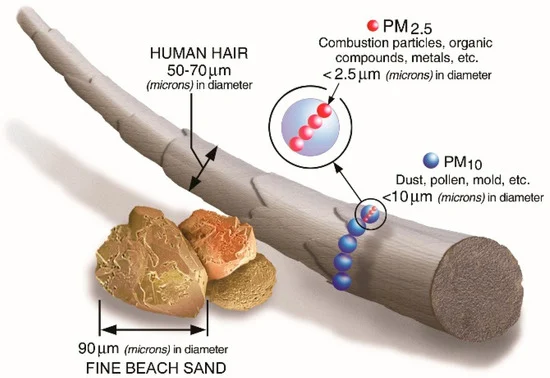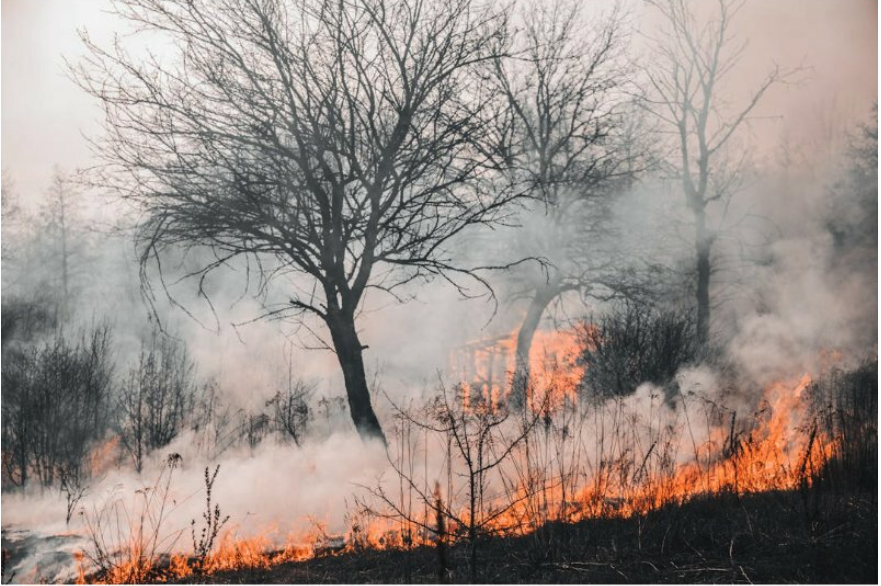As the planet continues to warm due to climate change, wildfires/bushfires are becoming increasingly frequent, severe, and difficult to combat. According to a UN report, the escalating climate crisis and land-use changes are driving a global increase in extreme wildfires, with a 14% increase predicted by 2030 and a 30% increase by 2050. These fires not only endanger human lives and properties but also have profound and far-reaching impacts on our health and the natural world.
One particularly insidious aspect of wildfires is the smoke they produce, which carries hazardous pollutants that harm both humans and wildlife. As smoke events become more common, this growing concern demands our attention. In this blog post, we delve into the detrimental effects of wildfire smoke and explore how exci’s cutting-edge AI-powered wildfire detection technology can help mitigate these impacts.
The Health Impacts of Wildfire Smoke
Understanding Wildfire Smoke
Wildfire smoke is a complex mixture of gases and tiny particles that can penetrate deep into the lungs and bloodstream. Key components include fine particulate matter (PM2.5), carbon monoxide (CO), hydrogen cyanide (HCN), and various volatile organic compounds (VOCs). PM2.5 particles, which are less than 2.5 micrometers in diameter, are particularly concerning due to their ability to lodge in the respiratory tract and cause inflammation.
[
Image Source: Xayasouk, T.; Lee, H.; Lee, G. Air Pollution Prediction Using Long Short-Term Memory (LSTM) and Deep Autoencoder (DAE) Models. Sustainability 2020, 12, 2570. https://doi.org/10.3390/su12062570
Acute and Chronic Health Effects of Bushfires
Exposure to wildfire smoke has been linked to a range of adverse health outcomes. Short-term effects include respiratory issues such as coughing, throat irritation, and exacerbation of asthma. While a generally healthy body can manage short-term exposure, the severity of health impacts often depends on the “dose of the poison”. High levels of smoke can impair macrophage function, leading to bacterial persistence and an increased inflammatory response, exacerbating health risks.
Studies have shown that people exposed to high levels of PM2.5 during wildfire events experience an increase in hospital admissions for respiratory and cardiovascular conditions. Long-term exposure can lead to chronic respiratory diseases, cardiovascular problems, and even premature death.

Macrophages found in alveoli. Image Source: fhttps://theconversation.com/wildfire-smoke-can-harm-human-health-even-when-the-fire-is-burning-hundreds-of-miles-away-a-toxicologist-explains-why-206057
For instance, studies by McClure and Jaffe (2018) and Clay and Muller (2019) found that wildfires significantly contribute to increased annual concentrations of PM2.5 in the United States. These spikes in particulate matter have been linked to a rise in respiratory and cardiovascular hospital admissions, as documented by Cascio (2018) and Chen et al. (2021). Additionally, the Washington State Academy of Sciences (2019) and Liu et al. (2021) highlighted extreme air pollution episodes in the Pacific Northwest caused by wildfire smoke, with PM2.5 concentrations far exceeding the National Ambient Air Quality Standards.
The toxic nature of wildfire smoke, often more harmful than urban air pollution, compounds these health risks. Research by Franzi et al. (2011) and Aguilera et al. (2021) shows that the chemical composition of PM2.5 in wildfire smoke is particularly hazardous, making it a critical public health issue that necessitates urgent attention and action.
Emerging Concerns: Brain Health and Dementia
New research suggests that wildfire smoke may pose a greater risk to brain health than other types of air pollution, potentially increasing the risk of dementia, cognitive challenges, and mental health issues. A study presented at the Alzheimer’s Association International Conference analyzed health records of 1.2 million older adults in Southern California from 2009 to 2019, estimating their exposure to fine particulate matter (PM2.5) from various sources, including wildfires. The findings revealed a 21% increase in dementia risk for every 1 microgram rise in wildfire-related PM2.5, compared to a 3% increase for every 3 microgram rise from other sources.
This disparity underscores the unique and severe impact of wildfire smoke on brain health. Although the exact mechanisms are still unclear, the study highlights the urgent need for further research, especially as the frequency and intensity of wildfires continue to rise. Moreover, lower-income populations are at higher risk due to their limited ability to avoid poor air quality, underscoring the importance of health warnings about staying indoors when air quality deteriorates.
The Impact on Wildlife of Wildfires
Direct Health Effects
Wildlife is equally vulnerable to the dangers of wildfire smoke. Animals inhaling smoke can suffer from severe health issues, including respiratory distress, carbon monoxide poisoning, and long-term lung damage. Research shows that smoke inhalation can lead to respiratory and cardiovascular diseases, neurological impairments, and immunosuppression in both terrestrial and aquatic species, affecting their behaviour and survival.
Case studies in veterinary medicine, such as those by Fitzgerald and Flood (2006) and Marsh (2007), demonstrate that domestic animals, including pets and livestock, are susceptible to smoke inhalation. These cases illustrate that, like humans, animals can suffer from carbon monoxide poisoning, thermal and chemical damage to lung tissue, and increased susceptibility to respiratory disease due to smoke inhalation.
Animal models used to study human diseases further underscore the severity of these impacts. Research involving mice, rats, rabbits, sheep, and monkeys (David et al., 2009) reveals that exposure to toxic gases and aerosols in smoke can lead to acute and chronic health issues similar to those observed in humans. Notably, Wohlsein et al. (2016) documented significant health problems in wildlife species exposed to wildfire smoke, including respiratory distress and increased mortality rates.
 Conceptual model illustrating wildfire smoke influence on wildlife and ecosystems.[/caption]
Conceptual model illustrating wildfire smoke influence on wildlife and ecosystems.[/caption]
Image credit: Sanderfoot et al. 2021
Behavioural Changes
The presence of wildfire smoke can also alter animal behaviour. Some species, like birds, are highly sensitive to air quality and may experience increased stress and disrupted breeding patterns due to smoke exposure. In contrast, certain animals might be attracted to smoke because it signals new resources or breeding opportunities in recently burned areas.
For example, fire-chaser beetles use smoke to locate suitable habitats for laying their eggs. Similarly, birds of prey, such as Swainson’s hawks, increase their hunting activity during smoke events, taking advantage of fleeing prey. However, these behavioural adaptations may not always be beneficial, especially if smoke conditions are extreme or prolonged.
Research by Engstrom (2010) and Nimmo et al. (2021) highlights the direct threats that wildfires, including smoke exposure, pose to wildlife. Studies by Hovick et al. (2017), Lee et al. (2017), Erb et al. (2018), and Geiser et al. (2018) further emphasize that smoke inhalation can cause significant changes in movement and vocalization among wildlife species. These behavioural changes can impact demographic rates, including growth, development, survival, and reproductive success, ultimately influencing population dynamics and ecosystem health.
exci’s AI-Wildfire/Bushfire Detection Technology Mitigates Wildfire Smoke Impact
Early Detection and Rapid Response
Timely detection of wildfires is crucial to mitigating their effects. exci’s advanced AI-powered wildfire/bushfire detection technology offers a promising solution to address the challenges caused by wildfire smoke. Our advanced AI analyses data from cameras and satellites to detect smoke and thermal anomalies indicative of wildfires. Once a fire is detected, exci’s system immediately notifies relevant responders, enabling rapid response and potentially preventing small fires from escalating into large, uncontrollable blazes.
exci’s AI has been meticulously trained using an unparalleled large dataset exclusively owned by exci. During the Californian fire season of 2020/21 alone, exci’s AI processed over 1 billion camera images from 1,000 cameras and analysed 500,000 satellite images, covering more than 130 million acres across North America. Since its inception in 2019, exci’s AI has been continually refined and enhanced, detecting over 140,000 wildfires and counting. In Australia, the system protects over 30 million acres of plantations and forestry, showcasing its global applicability and effectiveness.
 exci’s AI-wildfire detection technology
exci’s AI-wildfire detection technology
Enhancing Public Health Response
exci’s technology is vital in enhancing public health response by ensuring the timely detection of wildfires. Early detection of wildfires allows authorities to advise the public on protective measures, such as staying indoors or using air purifiers, thereby reducing exposure to harmful smoke.
Tips to Limit Exposure to Smoke
- Stay Informed: Keep track of air quality updates from reliable sources. Use apps and websites that provide real-time air quality indices to know when it is safe to go outside.
- Stay Indoors: When air quality is poor, limit outdoor activities. Stay inside as much as possible, and keep windows and doors closed to prevent smoke from entering your home.
- Use Air Purifiers: Invest in high-efficiency particulate air (HEPA) purifiers to reduce indoor smoke pollution. These devices can filter out PM2.5 particles and other pollutants, making indoor air safer to breathe.
- Create a Clean Room: Designate a room in your home as a clean air sanctuary. Use an air purifier and keep doors and windows closed to maintain good air quality in this space.
- Wear Masks: When outdoor exposure is unavoidable, wear N95 masks to filter out harmful particles. Simple cloth masks are not effective against PM2.5 particles.
- Seek Shelter: If your home does not provide adequate protection from smoke, consider staying with friends or family members in less affected areas, or find public shelters that offer clean air.

Long-Term Health Strategies
Chronic exposure to wildfire smoke necessitates robust long-term health strategies. As bushfire seasons intensify and smoke events become more frequent, communities must invest in infrastructure improvements, such as upgrading HVAC systems in public buildings and homes to effectively filter out pollutants. Additionally, public health campaigns are crucial to educate people on the risks associated with smoke exposure and practical measures to protect themselves during prolonged smoke events.
Effective management of these risks requires access to real-time air quality data and forecasts, enabling individuals to plan their activities and reduce exposure based on current conditions. Consistent, location-specific air quality information is essential for guiding daily behaviour and minimising health impacts. Collaborative efforts between health, environmental, and emergency response agencies, coupled with public education and infrastructure enhancements, are vital for addressing the long-term challenges posed by wildfire smoke.
Protecting Wildlife
Wildlife conservation efforts also benefit from exci’s AI-powered detection technology. By identifying fires early, our system helps protect critical habitats from being destroyed. This is particularly important for species that are already vulnerable due to habitat loss and other environmental pressures.
Additionally, understanding fire patterns and their impact on wildlife can inform conservation strategies. For example, by monitoring how different species respond to smoke and fire, conservationists can develop targeted programs to support species recovery and habitat restoration in post-fire landscapes.
Conclusion
Wildfire smoke poses a significant threat to both human health and wildlife. As climate change intensifies the frequency and severity of wildfires, the need for effective detection and response strategies becomes ever more critical. exci’s AI-powered wildfire detection technology offers a powerful tool to mitigate the impacts of wildfires. By providing early detection and rapid response capabilities, our technology helps protect communities, reduce health risks, and conserve vital wildlife habitats. As we continue to refine and expand our capabilities, we remain committed to safeguarding our planet from the growing threat of wildfires and their devastating consequences.
exci is proud to be Australian-made and owned, dedicated to leveraging our expertise and technology to make a global impact in the fight against wildfires. Through innovation and dedication, we strive to create a safer, healthier future for both people and wildlife.
by Gabrielle Tylor
exci – The Smoke Alarm for the Bus
AI-powered Wildfire/Bushfire Detection Technology
13 August 2024
Don’t let hazardous events escalate into catastrophes!
Reach out to our friendly team today for a comprehensive demonstration of exci’s system and learn how it can safeguard your assets while protecting your community.
email: info@exci.ai
International Phone: +61 458 594 554
Visit our website at https://www.exci.ai/ to learn more and take the first step towards a safer and more resilient future.

